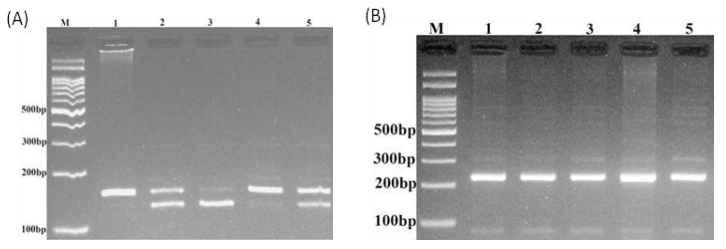1. Introduction
Opioid abuse is an important major social and economic problem worldwide. The annual global prevalence of opioid abuse was estimated at between 28 and 38 million users [1]. Physiological dependence is one of the key features that maintain repeated opioid use, contributing significantly to the cycle of chronic use/abuse [2]. It has been proposed that genetic and environmental factors contribution to individual differences in vulnerability to drug addictions. Heroin addiction is a chronic disease characterized by compulsive drug seeking, drug abuse, tolerance and physical dependence. Twin studies have proposed that genetic factors account for nearly 30%–60% of the overall variance in the risk of developing drug addiction [3,4,5].
µ-opioid receptor gene (OPRM1; OMIM# 600018) located on chromosome 6 (6q25.2) is a primary target of opioids. The OPRM1 receptor, a membrane of the G protein-coupled receptor (GPCR) family [6], interacts with multiple endogenous opioid peptides such as beta-endorphin endomorphins [7,8] as well as of numerous opioid analgesic agents and drugs including morphine, methadone, fentanyl and heroin [9,10,11].
A common functional polymorphism in exon 1 of OPRM1 (rs1799971 or 118A > G) results in an Asn40Asp amino-acid change increase the affinity of the receptor to its ligands [6]. Several studies evaluated the impact of OPRM1 polymorphisms on heroin dependence but the findings were inconsistent [12,13,14,15,16,17].
To the best of our knowledge, there is no data regarding the impact of OPRM1 polymorphisms on heroin addiction in Iranian population. Thus, in the current study we focus on the association between OPRM1 rs1799971 (A118G, Asn40ASp) and rs9479757 gene polymorphisms and the risk of heroin addiction in a sample of southeast Iranian population.
2. Materials and Methods
2.1. Patients
This case-control study was done in Zahedan (southeast Iran) on 123 heroin addicts men who referred to Baharan Hospital (Psychiatric hospital of Zahedan University of Medical Sciences) for methadone maintenance therapy and 140 healthy men who declared that they did not suffer substance abuse. The local Ethics Committee of the Zahedan University of Medical Sciences approved the project, and written informed consent was taken from all individuals. Two milliliter of venous blood was drawn from each participant and genomic DNA was extracted by using salting out method [18].
2.2. Genotyping
Genotyping of OPMR1 polymorphisms was done by polymerase chain reaction-restriction fragments polymorphism (PCR-RFLP). The primers are listed in Table 1. In each 0.20 mL PCR reaction tube, 1 µL of genomic DNA (~100 ng/mL), 1 µL of each primer (10 µM) and 10 µL of 2 × Prime Taq Premix (Genet Bio, Korea) and 7 µL ddH2O were added. The PCR cycling conditions were set as follows: 95 ℃ for 5 min, 30 cycles of 95 ℃ for 30 s, annealing temperature (62 ℃ for rs1799971 and 66 ℃ for rs1799971) for 30 s, and 72 ℃ for 30 s and a final extension step of 72 ℃ for 10 min. Ten microliter of PCR product were digested by appropriate restriction enzyme (Table 1) and the fragments analyzed by electrophoresis on a 2.5% agarose gel containing 0.5 μg/mL of ethidium bromide and transilluminated with ultraviolet light and digitally imaged for genotyping (Figure 1).
Table 1. Primers sequences for detection of OPRM1 polymorphisms using PCR-RFLP method.
| OPRM1 Polymorphisms |
Primer sequence (5'-3') |
Restriction enzyme |
Fragment (bp) |
| rs1799971 A > G |
GTCTCGGTGCTCCTGGCTACCTCGC (F) TTCGGACCGCATGGGTCGGACCGGT (R) |
Bsh1285I |
A allele: 153 + 44 G allele: 129 + 44 + 24 |
| rs9479757 G > A |
AGCATATTCACCCTCTGCACC (F) CACCAACATATCAGGCTGTGAAGC (R) |
AluI |
G allele: 233 A allele: 210 + 23 |
2.3. Statistical analysis
Statistical analysis was done by statistical package SPSS 22 software. Data were analyzed by independent sample t-test or χ2 test according to the data. Odds ratio (OR) and 95% confidence intervals (95%CI) were calculated from unconditional logistic regression analyses to find out the possible association between the variants and heroin dependence. A P-value less than 0.05 were considered statistically significant.
3. Results
Totally 263 subject including 123 heroin addicts men with an age average 38.50 ± 11.7 years and 140 healthy men with an average age of 35.7 ± 11.1 years were included in the study. No significant difference was found between the groups regarding age (P = 0.212).
Table 2 shows the genotype and allele frequencies of OPMR1 rs1799971 A > G polymorphism in heroin addiction and healthy subjects. The findings proposed that this variant was not associated with heroin dependence. Regarding rs9479757 G > A variant of OPMR1 gene, our findings revealed that this variant was not polymorphic in our population and all cases and controls were GG genotype.
Table 2. Genotype and allele frequency of OPRM1 rs1799971 A > G polymorphism in heroin addiction and control subjects.
| rs1799971 A > G Polymorphism |
Case (%) |
Control (%) |
OR (95%CI) |
P-value |
| AA |
84 (68.30) |
100 (71.40) |
1.00 |
- |
| AG |
34 (27.60) |
30 (21.40) |
1.35(0.73–2.48) |
0.376 |
| GG |
5 (4.10) |
10 (7.20) |
0.60 (0.17–1.99) |
0.514 |
| AG + GG |
39 (31.7) |
40 (28.6) |
1.16 (0.68–1.97) |
0.592 |
| Allele |
|
|
|
|
| A |
202 (82.11) |
230 (82.14) |
1.00 |
- |
| G |
44 (17.89) |
50 (17.86) |
1.00 (0.63–1.60) |
0.916 |
4. Discussion
Drug addiction continues to be a serious medical and social problem. Genes encoding the opioid receptors (OPRM1, OPRD1 and OPRK1) are potentially candidates for association with the risk of heroin addiction. In the present study, we examined the impact of OPRM1 rs1799971 (A118G, Asn40ASp) and rs9479757 polymorphisms on heroin dependence in a sample of southeast Iranian population. The findings presented here propose that rs1799971 variant was not associated with heroin dependence in the population studied. We found that the OPRM1 rs9479757 variant was not polymorphic and all participants were GG genotype. Beer et al [19] investigated the impact of OPRM1 rs9479757 variant on opioid dependence in European population. In contrast to our findings, they found that the frequencies of GG, GA and AA genotypes of OPRM1 rs9479757 variant in cases and controls were 0.92, 0.8, 0.01 and 0.84, 0.16, 0.0, respectively. The GA genotype was associated with protection against opioid dependence.
OPRM1 rs9478495, rs3778150, rs9384169 and rs562859 polymorphisms of OPRM1 gene have been shown to be associated with the risk of heroin addiction [20]. Genetic findings suggest that sequence variations OPRK1 genes which encode the kappa-opioid receptors associated with the risk for alcohol dependence as well as opioid and cocaine dependence [21,22]. Glatt et al [23] have found no significant association between the Asn40Asp polymorphism and opioid dependence in the family-based association analysis as well as a meta-analysis of case-control studies. A meta-analysis performed by Haerian et al [12] revealed that the nonsynonymous OPRM1 rs1799971 (A118G, Asp40Asp) might be a risk factor for addiction to opioids or heroin in an Asian population. Nikolov et al [24] have found no significant association between OPRM1 rs1799971 and heroin addiction in Bulgarian population. No significant association was observed between OPRM1 polymorphisms and severe opioid dependence [25].
It has been shown that rs1799971 (A118G, Asn40ASp) variant of OPRM1 is associated with heroin addiction [13] as well as alcoholic addition [26,27]. While, rs16918875, rs963549 and rs702764 polymorphisms of OPRK1 were not associated with heroin addiction or alcoholic addition [26]. Franke [14] have found no significant association between rs1799971 polymorphism of the OPRM1 and risk of heroin and alcohol dependence. Xu et al [15] have found no significant association for a role of OPRM1 17 T > C and 24 G > A as well as OPRD1 921 T > C and heroin dependence. Clarke et al [16] findings showed an association between OPRM1 rs62638690 and cocaine and heroin addiction in European Americans [16]. It has been shown that OPRM1 rs1799971 contributes to individual differences in sensitivity to the rewarding effects of alcohol. The rs1799971 variant is thought to increase receptor binding affinity for β-endorphin by threefold [6]. The functional rs1799971 (A118G, Asn40Asp) polymorphism of OPRM1 gene has been shown to be associated with heroin use outcomes in Caucasian males [28].
Epigenetics refers to heritable and possibly reversible modifications in gene expression that do not involve changes to the underlying DNA sequence. Various mode of epigenetics including DNA methylation, histone modification, chromatin remodeling and non-coding RNA-mediated processes are supposed to influence gene expression [29,30,31]. Structural and functional changes in the brain accompany repeated exposure to drugs of abuse propose that alterations in gene regulation contribute substantially to the addictive phenotype [29,31].
Recently, Ebrahimi et al [32] showed promoter hypermethylation of OPRM1 in opium use disorder.
The inconsistency between the findings may be related to genetic and environmental differences between the populations studied. One of the limitations of this study is relatively small sample sizes. The power of the study was not enough to detect a mild or moderate association between OPMR1 and heroin addiction.
In conclusion, our findings did not support an association between OPRM1 rs1799971 variant and risk of heroin dependence in a sample of Iranian population, but this is not definitive. Larger sample sizes with different ethnicities are required to validate our findings.
Acknowledgements
This work was supported by a dissertation grant (MD thesis of ZR#7258) from Zahedan University of Medical Sciences.
Conflict of Interest
The authors declare that there is no conflict of interest to disclose.









 DownLoad:
DownLoad: 




